display OLDSMOBILE SILHOUETTE 1997 Owners Manual
[x] Cancel search | Manufacturer: OLDSMOBILE, Model Year: 1997, Model line: SILHOUETTE, Model: OLDSMOBILE SILHOUETTE 1997Pages: 436, PDF Size: 21.87 MB
Page 115 of 436
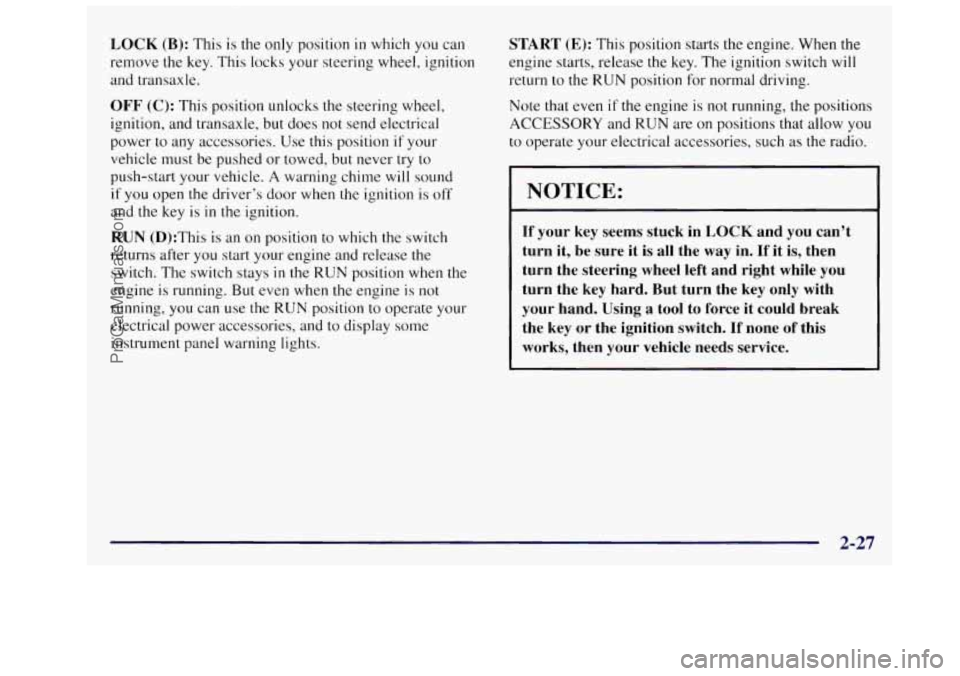
LOCK (B): This is the only position in which you can
remove
the key, This locks your steering wheel, ignition
and transaxle.
OFF (C): This position unlocks the steering wheel,
ignition, and transaxle, but does not send electrical
power to any accessories. Use this position if your
vehicle must be pushed or towed, but never try to
push-start your vehicle.
A warning chime will sound
if you open the driver’s door when the ignition is off
and the key is in the ignition.
RUN (D):This is an on position to which the switch
returns after
you start your engine and release the
switch. The switch stays
in the RUN position when the
engine is running. But even when
the engine is not
running, you can use the
RUN position to operate your
electrical power accessories, and to display some
instrument panel warning lights.
START (E): This position starts the engine. When the
engine starts, release the key. The ignition switch will
return to the
RUN position for normal driving.
Note that
even if the engine is not running, the positions
ACCESSORY and RUN are on positions that allow you
to operate your electrical accessories, such as the radio.
NOTICE:
If your key seems stuck in LOCK and you can’t
turn it, be sure it is all the
way in. If it is, then
turn the steering wheel left and right while
you
turn the key hard. But turn the key only with
your hand. Using
a tool to force it could break
the key
or the ignition switch. If none of this
works, then your vehicle needs service.
2-27
ProCarManuals.com
Page 159 of 436
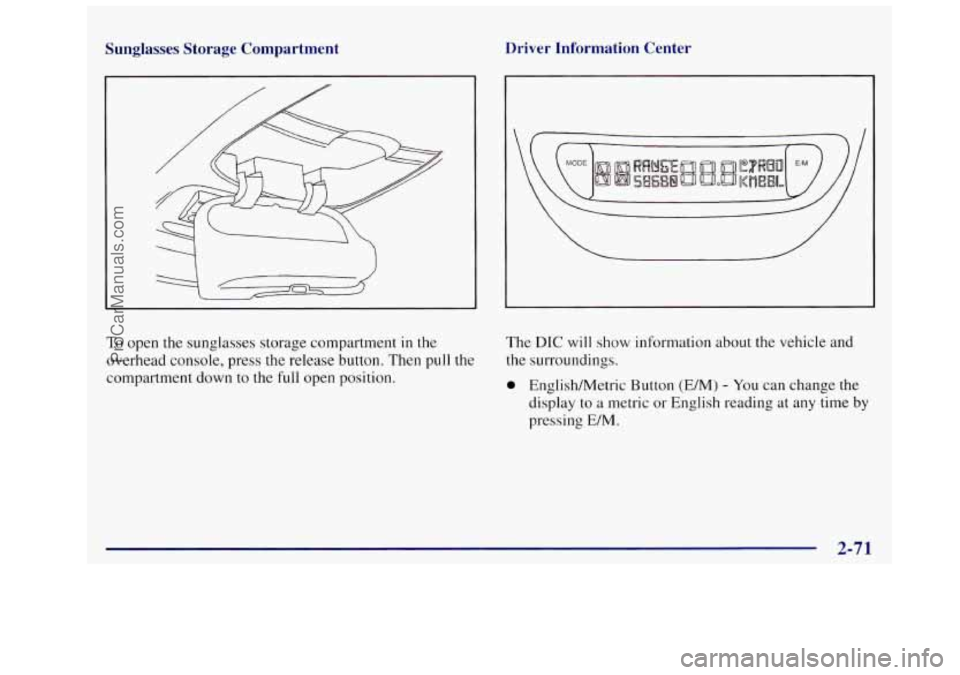
Sunglasses Storage Compartment Driver Information Center
To
open the sunglasses storage compartment in the
overhead console, press the release button. Then pull the
compartment down to the full open position. The DIC will show information about the vehicle and
the surroundings.
0 English/Metric
Button (E/M) - You can change the
display
to a metric or English reading at any time by
pressing
E/M.
ProCarManuals.com
Page 160 of 436
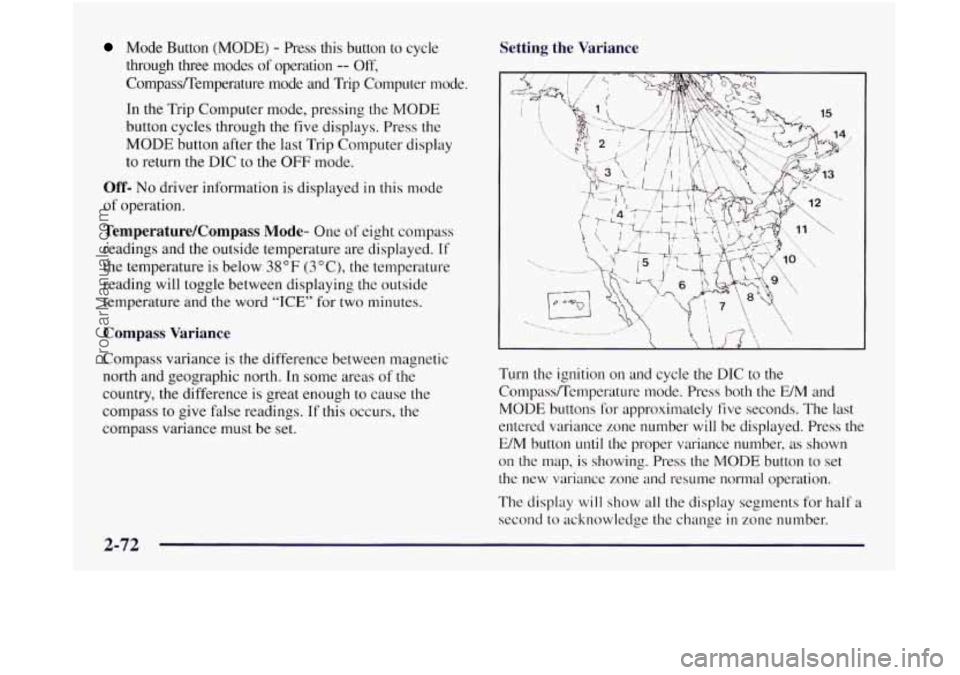
Mode Button (MODE) - Press this button to cycle
through
three modes of operation -- Off,
Compass/"T'emperature mode and Trip Computer mode.
In the Trip Computer mode, pressing the MODE
button cycles through
the five displays. Press the
MODE button after the last Trip Computer display
to return the DIC to the OFF mode.
Off- No driver information is displayed in this mode
of operation.
TemperatureKompass Mode- One of eight compass
readings and the outside temperature are displayed.
If
the temperature is below 38°F (3"C), the temperature
reading will toggle between displaying the outside
temperature and
the word "ICE" for two minutes.
Compass Variance
Compass variance is the difference between magnetic
north and geographic north. In some areas of the
country, the difference is great enough to cause the
compass to give false readings.
If this occurs, the
compass variance must be set.
Setting the Variance
Turn the ignition on and cycle the DIC to the
CompassRemperature mode. Press both the E/M and
MODE buttons for approximately five seconds. The last
entered variance zone number will be displayed. Press the
E/M button
until the proper variance number, as shown
on the map,
is showing. Press the MODE button to set
the new variance zone
and resume normal operation.
The display
will show all the display segments for half a
second to acknowledge the change
in zone number.
2-72
ProCarManuals.com
Page 161 of 436
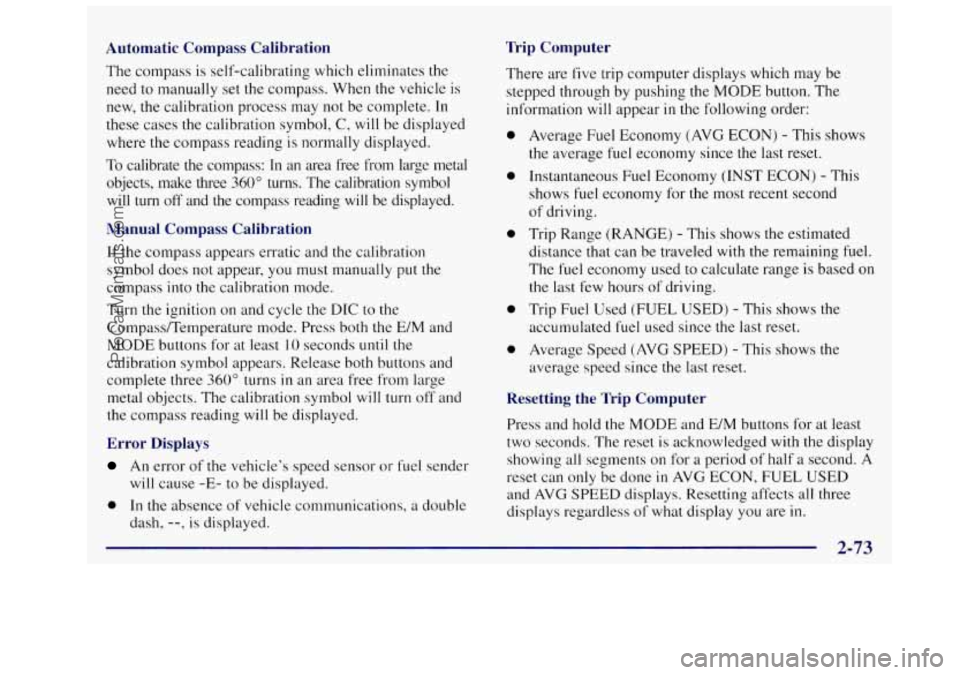
Automatic Compass Calibration
The compass is self-calibrating which eliminates the
need to manually set the compass. When the vehicle is
new,
the calibration process may not be complete. In
these cases the calibration symbol, C, will be displayed
where
the compass reading is normally displayed.
To calibrate the compass: In an area free from large metal
objects, make three
360" turns. The calibration symbol
will turn
off and the compass reading will be displayed.
Manual Compass Calibration
If the compass appears erratic and the calibration
symbol does not appear, you must manually put
the
compass into the calibration mode.
Turn the ignition on and cycle the DIC to the
CompadTernperature mode. Press both the E/M and
MODE buttons for at least
10 seconds until the
calibration symbol appears. Release both buttons and
complete three
360" turns in an area free from large
metal objects.
The calibration symbol will turn off and
the compass reading will be displayed.
Error Displays
An error of the vehicle's speed sensor or fuel sender
0 In the absence of vehicle communications, a double
will
cause
-E- to be displayed.
dash,
--, is displayed.
Trip Computer
There are five trip computer displays which may be
stepped through by pushing the MODE button. The
information will appear
in the following order:
0
0
0
0
0
Average Fuel Economy (AVG ECON) - This shows
the average fuel economy since the last reset.
Instantaneous Fuel Economy (INST ECON)
- This
shows fuel economy for the most recent second
of driving.
Trip Range (RANGE)
- This shows the estimated
distance that can be traveled with the remaining fuel.
The fuel economy used to calculate range is based on
the last few hours
of driving.
Trip Fuel Used (FUEL USED)
- This shows the
accumulated fuel used since the last reset.
Average Speed (AVG
SPEED) - This shows the
average speed since the last reset.
Resetting the Trip Computer
Press and hold the MODE and E/M buttons for at least
two seconds. The reset
is acknowledged with the display
showing all segments on for a period of half
a second. A
reset can only be done
in AVG ECON, FUEL USED
and AVG
SPEED displays. Resetting affects all three
displays regardless of what display you are in.
ProCarManuals.com
Page 180 of 436

Tachometer
' -3
1 +2
-1
The tachometer displays the engine speed in revolutions
per minute (rpm).
1 NOTICE:
Warning Lights, Gages
and Indicators
This part describes the warning lights and gages that
may be on your vehicle. The pictures will help you
locate them.
Warning lights and gages can signal that something is
wrong before
it becomes serious enough to cause an
expensive repair or replacement. Paying attention to
your warning lights and gages could also save you or
others from injury.
Warning lights come
on when there may be or is a
problem with one of your vehicle's functions.
As you
will see
in the details on the next few pages, some
warning lights come on briefly when you start the
engine just to
let you know they're working. If you are
familiar
with this section, you should not be alarmed
when this happens.
Do not operate the engine with the tachometer in
the red area, or engine damage may occur.
2-92
ProCarManuals.com
Page 203 of 436

Setting the Clock for Systems with
NOTICE: Automatic Tone Control
Press and hold HR until the correct hour appears. Press
and hold
MN until the correct minute appears. Don’t use a razor blade or something else sharp
on the inside of the rear window. If you do, you
could cut or damage the warming grid, and the
AM-FM Stereo
I repairs wouldn’t be covered by your warranty.
I
Audio Systems
Your Deb@ audio system has been designed to operate
easily and give years
of listening pleasure. You will get
the most enjoyment out of it if you acquaint yourself
with it first. Find out what your Delco system can do
and how to operate all its controls, to be sure you’re
getting the most out of the advanced engineering that
went into
it.
Setting the Clock for Systems without
Automatic Tone Control
Press SET. Set will appear on the display for five
seconds. Within five seconds, press and hold
the right
arrow on the
SEEK button until the correct minute
appears. Press and hold the left arrow on
the SEEK
button until the correct hour appears.
Playing the Radio
VOLUME: This knob turns the system on and off and
controls the volume.
To increase volume and turn the
radio on, turn the knob clockwise. Turn it
counterclockwise to decrease volume.
3-9
ProCarManuals.com
Page 204 of 436
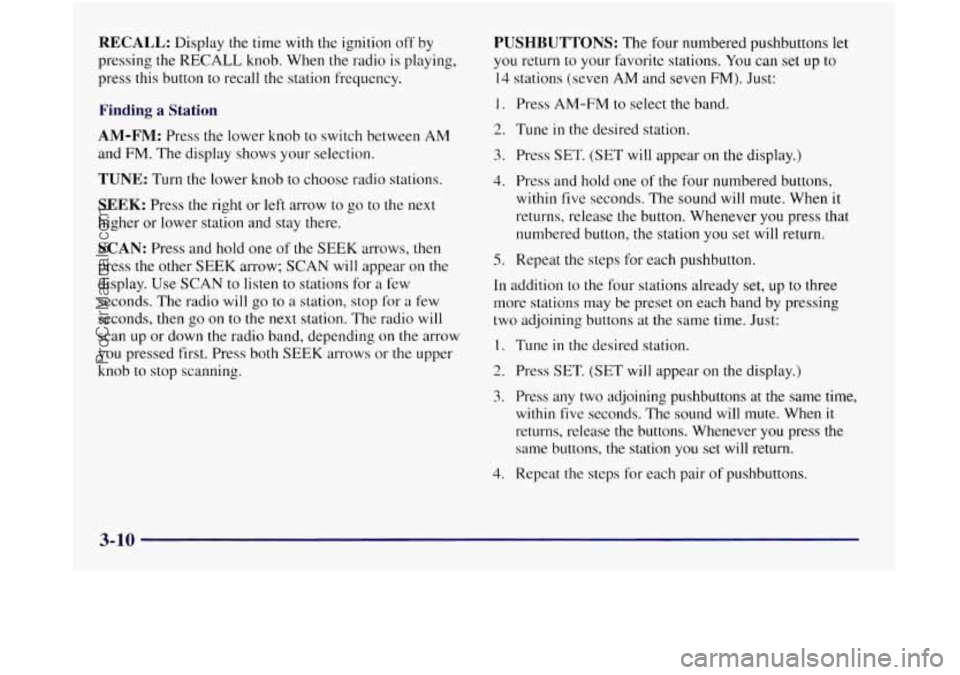
RECALL: Display the time with the ignition off by
pressing the RECALL knob. When
the radio is playing,
press this button to recall
the station frequency.
Finding a Station
AM-FM: Press the lower knob to switch between AM
and FM. The display shows your selection.
TUNE: Turn the lower knob to choose radio stations.
SEEK: Press the right or left arrow to go to the next
higher or lower station and stay there.
SCAN: Press and hold one of the SEEK arrows, then
press the other SEEK arrow;
SCAN will appear on the
display. Use
SCAN to listen to stations for a few
seconds. The radio will
go to a station, stop for a few
seconds,
then go on to the next station. The radio will
scan up or down the radio band, depending on the arrow
you pressed first. Press both
SEEK arrows or the upper
knob to stop scanning.
PUSHBUTTONS: The four numbered pushbuttons let
you return to your favorite stations. You can set up to
14 stations (seven AM and seven FM). Just:
1. Press AM-FM to select the band.
2. Tune in the desired station.
3. Press SET. (SET will appear on the display.)
4. Press and hold one of the four numbered buttons,
within five seconds. The sound will mute. When
it
returns, release the button. Whenever you press that
numbered button, the station you set will return.
5. Repeat the steps for each pushbutton.
In addition to the four stations already set, up to three
more stations may be preset on each band by pressing
two adjoining buttons at the same time. Just:
1. Tune in the desired station.
2. Press SET. (SET will appear on the display.)
3. Press any two adjoining pushbuttons at the same time,
within five seconds.
The sound will mute. When it
returns, release the buttons. Whenever you press the
same buttons,
the station you set will return.
4. Repeat the steps for each pair of pushbuttons.
3-10
ProCarManuals.com
Page 206 of 436
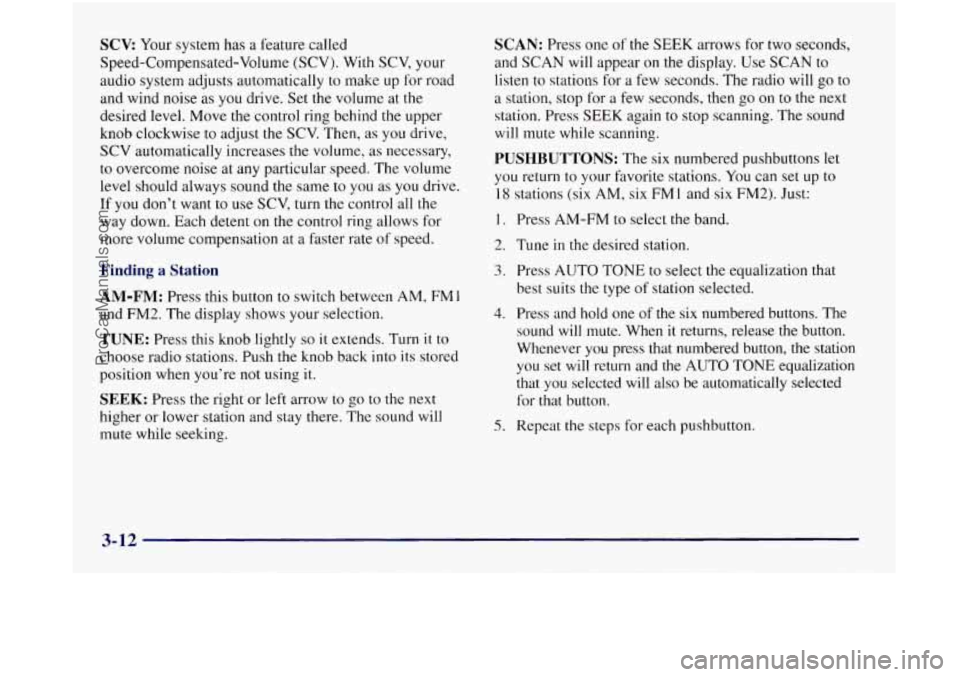
SCV: Your system has a feature called
Speed-Compensated-Volume (SCV). With SCV, your
audio system adjusts automatically to make up for road
and wind noise as you drive. Set the volume at the
desired level. Move the control ring behind the upper
knob clockwise to adjust the SCV. Then, as you drive,
SCV automatically increases the volume, as necessary,
to overcome noise at any particular speed. The volume
level should always sound the same to you as you drive.
If you don’t want to use SCV, turn the control all the
way down. Each detent on the control ring allows for
more volume compensation at a faster rate of speed.
Finding a Station
AM-FM: Press this button to switch between AM, FMl
and FM2. The display shows your selection.
TUNE: Press this knob lightly so it extends. Turn it to
choose radio stations. Push the knob back into its stored
position when you’re not using it.
SEEK: Press the right or left arrow to go to the next
higher or lower station and stay there. The sound will
mute while seeking.
SCAN: Press one of the SEEK arrows for two seconds,
and SCAN will appear on
the display. Use SCAN to
listen to stations for a few seconds. The radio will go
to
a station, stop for a few seconds, then go on to the next
station. Press
SEEK again to stop scanning. The sound
will mute while scanning.
PUSHBUTTONS: The six numbered pushbuttons let
you return to your favorite stations. You can set up to
18 stations (six AM, six FMl and six FM2). Just:
I. Press AM-FM to select the band.
2. Tune in the desired station.
3. Press AUTO TONE to select the equalization that
best suits the type of station selected.
4. Press and hold one of the six numbered buttons. The
sound will mute. When
it returns, release the button.
Whenever you press that numbered button, the station
you set will return and the AUTO TONE equalization
that you selected will also be automatically selected
for that button.
5. Repeat the steps for each pushbutton.
3-12
ProCarManuals.com
Page 207 of 436
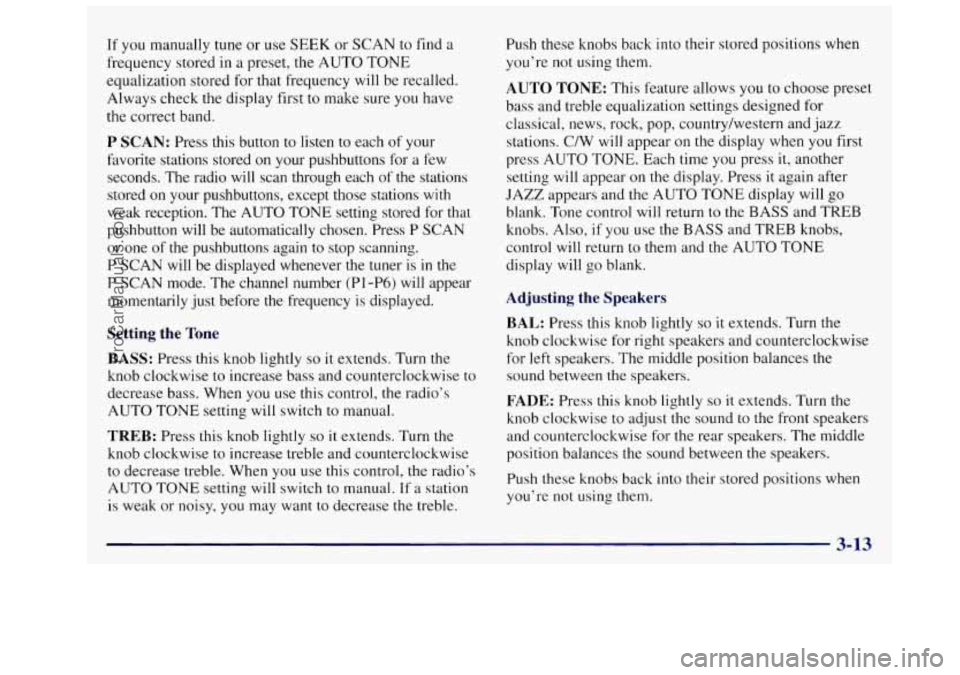
If you manually tune or use SEEK or SCAN to find a
frequency stored
in a preset, the AUTO TONE
equalization stored for that frequency will be recalled.
Always check the display first to make sure you have
the correct band.
P SCAN: Press this button to listen to each of your
favorite stations stored on your pushbuttons for
a few
seconds. The radio will scan through each of the stations
stored on your pushbuttons, except those stations with
weak reception. The AUTO TONE setting stored for that
pushbutton will be automatically chosen. Press P SCAN
or one
of the pushbuttons again to stop scanning.
P SCAN will be displayed whenever the tuner is in the
P SCAN mode. The channel number (P1 -P6) will appear
momentarily just before the frequency is displayed.
Setting the Tone
BASS:
Press this knob lightly so it extends. Turn the
knob clockwise to increase bass and counterclockwise to
decrease bass. When you use this control, the radio’s
AUTO TONE setting will switch
to manual.
TREB: Press this knob lightly so it extends. Turn the
knob clockwise to increase treble and counterclockwise
to decrease treble. When you use this control, the radio’s
AUTO
TONE setting will switch to manual. If a station
is weak or noisy, you may want
to decrease the treble. Push these knobs back into their stored
positions when
you’re not using them.
AUTO TONE: This feature allows you to choose preset
bass and treble equalization settings designed for
classical, news, rock, pop, countrylwestern and
jazz
stations. C/W will appear on the display when you first
press AUTO
TONE. Each time you press it, another
setting will appear on the display. Press
it again after
JAZZ appears and
the AUTO TONE display will go
blank. Tone control will return to the BASS and TREB
knobs. Also, if you use the BASS and TREB knobs,
control will return to them and the AUTO TONE
display will go blank.
Adjusting the Speakers
BAL:
Press this knob lightly so it extends. Turn the
knob clockwise for right speakers and counterclockwise
for left speakers. The middle position balances the
sound between the speakers.
FADE: Press this knob lightly so it extends. Turn the
knob clockwise to adjust the sound to the front speakers
and counterclockwise for the rear speakers. The middle
position balances the sound between the speakers.
Push these knobs back into their stored positions when
you’re not using them.
3-13
ProCarManuals.com
Page 208 of 436
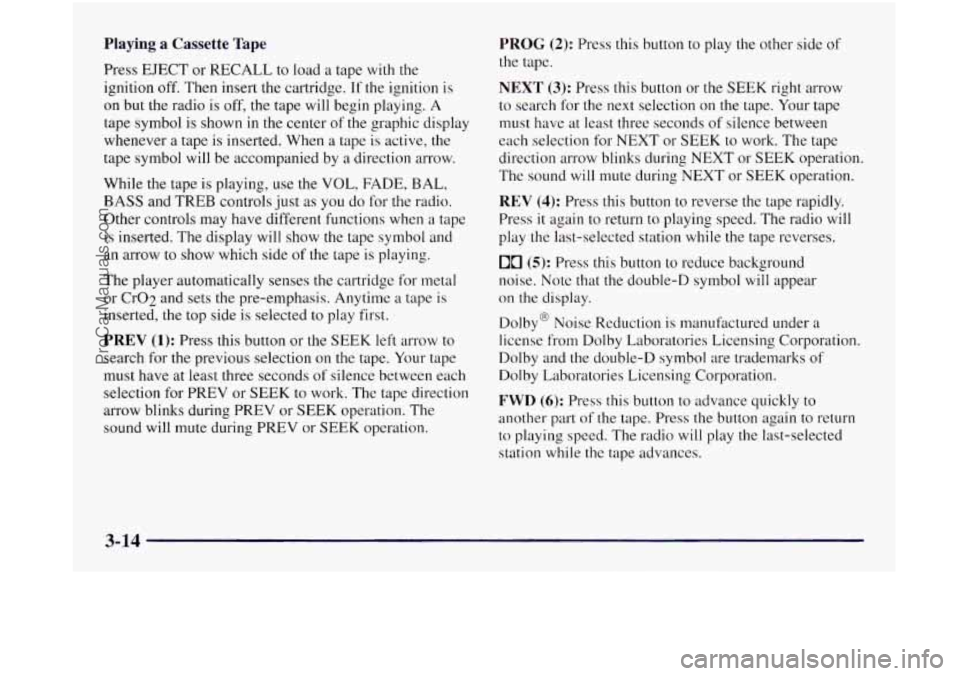
Playing a Cassette Tape
Press EJECT or RECALL to load a tape with the
ignition
off. Then insert the cartridge. If the ignition is
on but the radio is off,
the tape will begin playing. A
tape symbol
is shown in the center of the graphic display
whenever
a tape is inserted. When a tape is active, the
tape symbol will be accompanied by a direction arrow.
While the tape is playing,
use the VOL, FADE, BAL,
BASS and TREB controls just as you do for the radio.
Other controls may have different functions when a tape
is inserted. The display
will show the tape symbol and
an arrow to show which side
of the tape is playing.
The player automatically senses
the cartridge for metal
or Cr02 and sets the pre-emphasis. Anytime a tape
is
inserted, the top side is selected to play first.
PREV (1): Press this button or the SEEK left arrow to
search for the previous selection on the tape. Your tape
must have at least three seconds
of silence between each
selection for PREV or SEEK to work. The tape direction
arrow blinks during PREV or
SEEK operation. The
sound will mute during PREV or SEEK operation.
PROG (2): Press this button to play the other side of
the tape.
NEXT (3): Press this button or the SEEK right arrow
to search for the
next selection on the tape. Your tape
must have at least three seconds of silence between
each selection for NEXT or SEEK to work. The tape
direction arrow blinks during NEXT or SEEK operation.
The sound will mute during NEXT or SEEK operation.
REV (4): Press this button to reverse the tape rapidly.
Press
it again to return to playing speed. The radio will
play the last-selected station while the tape reverses.
00 (5): Press this button to reduce background
noise. Note that
the double-D symbol will appear
on the display.
Dolby@ Noise Reduction is manufactured under a
license from Dolby Laboratories Licensing Corporation.
Dolby and the double-D symbol are trademarks of
Dolby Laboratories Licensing Corporation.
FWD (6): Press this button to advance quickly to
another part of the tape. Press the button again
to return
to playing speed. The radio will play the last-selected
station while the tape advances.
3-14
ProCarManuals.com